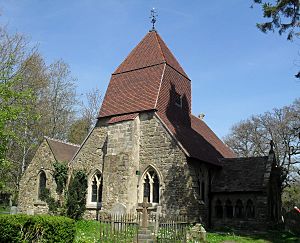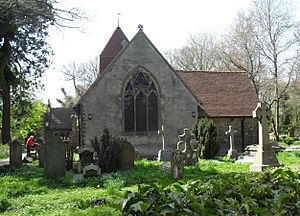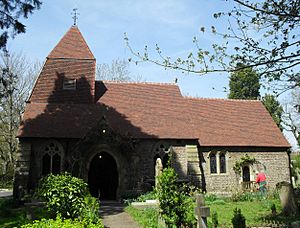Church in the Wood, Hollington facts for kids
Quick facts for kids Church in the Wood |
|
|---|---|
| St Leonard's Church | |

The church from the south
|
|
| 50°52′27″N 0°32′17″E / 50.8743°N 0.5380°E | |
| Location | Church in the Wood Lane, Hollington, Hastings, East Sussex TN38 9PB |
| Country | England |
| Denomination | Church of England |
| Website | www.stleonardsandstannes.org.uk |
| History | |
| Former name(s) | St Rumbold's Church |
| Status | Parish church |
| Founded | 11th century |
| Dedication | St Leonard |
| Architecture | |
| Functional status | Active |
| Heritage designation | Grade II |
| Designated | 19 January 1951 |
| Style | Early English Gothic |
| Administration | |
| Parish | Hollington: St Leonard and St Anne |
| Deanery | Rural Deanery of Hastings |
| Archdeaconry | Hastings |
| Diocese | Chichester |
| Province | Canterbury |
The Church in the Wood, also known as St Leonard's Church, is a special church in the Hollington area of Hastings, England. Even though Hollington is a big suburb today, this church has stood by itself in the middle of an old wood for centuries. It was first built in the 13th century, likely replacing an even older chapel from the 11th century. Over the years, especially during the Victorian era, the church was repaired and updated, giving it the look it has today. Some parts of the original medieval building are still there. Many interesting stories and even miracles are linked to this church. Writers like Charles Lamb have also admired its quiet, hidden location. The church is considered a Grade II Listed building, which means it's an important historic place.
Contents
A Look at Its Past
How Hollington Began
The area of Hollington was first mentioned in the Domesday Book in 1086. This was a big survey ordered by William the Conqueror to record land and property in England. Back then, Hollington was a "manor," which was a large estate with a main house and land. It was mostly a spread-out, rural settlement, not a crowded village.
Why the Church is in the Wood
When the Domesday survey happened, no church was mentioned in Hollington. However, a document from 1139 suggests a chapel was already on the church's current spot by 1090. This means it might be even older than the Norman Conquest! There were other chapels nearby, but they disappeared over time.
The main reason the church is so isolated is interesting. The ownership of the Hollington manor moved to a lord in a different area called Crowhurst. This lord didn't need the manor house in Hollington, so it was left empty. The chapel was the only building still used, and over time, a thick wood grew up around it, making it seem hidden away. For a long time, the church was about half a mile from the nearest house!
The old chapel was replaced by the current church in the mid-13th century. The first known vicar (the priest in charge) was John de Levenyngton in 1344.
How the Church Got Its Name
The church's official name, St Leonard's, came about in a bit of a confusing way. In 1291, there was another St Leonard's Church in Hastings, but it was lost by the early 1400s. People who used to go to that church started coming to the Hollington church instead.
The Church in the Wood was actually first called St Rumbold's Church in 1562. But slowly, over about 150 years, people started calling it St Leonard's Church, probably because of the old church that was lost. The name "Church in the Wood" became popular in the mid-1800s. This happened after a new St Leonard's Church was built in the town of St Leonards-on-Sea, and another church, St John the Evangelist's, was built in Hollington. To avoid confusion, people started using the descriptive name "Church in the Wood."
Repairs and Changes Over Time
Even though it was isolated, the church continued to serve its community. However, by the mid-1800s, it was in bad shape. Some people wanted to close it and build a new one closer to homes. But the local people insisted that their ancient church be fixed.
Repairs began in 1847 and lasted for almost 20 years. The church even closed for a while in 1861. Then, in 1865, a woman named Matilda Dampner paid for a complete restoration to honor her parents. The church reopened in 1866. These repairs were so big that the church ended up looking mostly Victorian, with only a few pieces of the very old Norman-era building remaining.
In 1870, the church's parish (the area it serves) became smaller when a new church, St John the Evangelist's, was built. Hollington became part of the town of Hastings in 1897. Later, in 1937, a lychgate (a covered gateway) was added to the churchyard entrance. More repairs happened in 1964, and a new room was added in 1977 for church activities.
The churchyard is very old and large. People have been buried there for centuries, with the first recorded burial in 1606. It's the last private burial ground left in Hastings.
Hollington's Growth
Hollington grew a lot in the 19th and 20th centuries. In 1831, about 338 people lived there, but by 1939, it was around 7,500! Even with this growth, it felt like a village until the 1960s. That's when the local council decided to build many new homes there. More houses were added later, and Hollington lost its quiet, rural feel. However, the old woodland around the church has been saved and is now a nature reserve.
What the Church Looks Like

The Church in the Wood looks mostly like it did after the big repairs in the 1800s. Only a few parts from the medieval times remain, like some stone in the walls, some old wooden beams, and an ancient bell in the tower. This bell was made between 1371 and 1392, making it the oldest bell in Hastings!
The church is built from local stone, and its roof is tiled. The pyramid-shaped top of the tower is also covered in tiles.
The church has a main hall called a nave, a special area for the altar called a chancel, and a bell tower at the west end. It also has a vestry (a room for the clergy), a porch, and a modern hall for parish events. The stone used is mostly local "bluestone," with some decorative parts made from "Bath Stone" and "Caen stone."
The church's style is called Early English Gothic. The window at the east end has three tall, narrow windows with beautiful stone patterns. In 1873, Jean-Baptiste Capronnier added a stunning stained glass window here that shows the Resurrection. Other windows show figures like Faith, Hope, and Charity, added in the late 1800s.
Stories and Legends
The unusual location of the Church in the Wood has led to some interesting stories. One legend, also told about other churches, says that the Devil didn't want the church built on its original spot. Every night, he would destroy the work done that day and move the building materials. A voice told the builders that the land belonged to the Devil and they should build the church somewhere else. So, they built it on the new spot, where the Devil was happy, and a wood grew around it to hide it. This story probably comes from the Middle Ages.
There's also a story about a miracle that happened to a vicar of the church in 1488. The story says he was robbed by three men who cut out his tongue and eyes so he couldn't identify them. But supposedly, his sight and speech were magically restored just in time for him to give evidence and help catch the robbers!
Many writers have been fascinated by the church's quiet beauty. In 1777, someone wrote that even though the churchyard had many nice monuments, it still felt like a hidden place in the middle of a wood. In 1874, it was simply described as "picturesquely situated in the heart of a romantic wood, having no hut or house of any kind within a quarter of a mile."
The writer Charles Lamb visited in 1823 and wrote a famous description:
The best thing I hit upon was a small country Church (by whom or when built unknown), standing bare and single in the midst of a grove, with no house or appearance of habitation within a quarter of a mile, only passages diverging from it through beautiful woods, to so many farm houses. There it stands, like the first idea of a Church, before parishioners were thought of, nothing but birds for its congregation...
—Charles Lamb, 1823
He thought it looked like the very first idea of a church, with only birds as its congregation!
The Church Today
The Church in the Wood was officially recognized as a Grade II Listed building on January 19, 1951. This means it's a very important historic building that needs to be protected.
The parish of St Leonard also includes another modern church called St Anne's Church. This church was built starting in 1956 to serve the growing number of homes in the area.
Today, there is one service every Sunday at 10:30 AM at Church in the Wood. St Anne's Church has a service every Sunday at 9:30 AM. In months with five Sundays, the two churches hold a special joint service together.
See also




